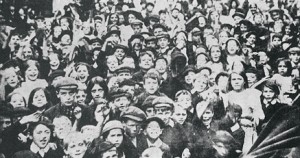
On September 13th 1911, staff of the East Wall Wharf National School arrived to work to be confronted with a sign that read ‘Any boy cot going into school and not following other schoolboys examples will be killed by order Strike Strike Strike’.
NewsFour spoke with East Wall and Dockland historian Joe Mooney about this strange and timely event.
It might be hard to imagine in the present era that school children might organise a union-style strike. But the events in East Wall two years before the great Dublin Lock-Out were part of a wave of children’s protests which swept across the UK that September. Sixty-two such protests are on record, taking place in areas such as Liverpool, Portsmouth and Southhampton. The actions derived from the port towns and manufacturing centres of what was then Britain’s industrial North.
Joe Mooney, who is currently collaborating on a book about the Schoolboy Strike, observed that “at the time there was a wave of strikes involving Dock workers and also a national rail strike. It’s quite clear that the pattern of school strikes mimics that of the general industrial unrest. It was a case of ‘like father like son’ as the children learned the tactics and put them into practice to address their own grievances.”
The strikers’ demands were simple – they wanted cheaper schoolbooks, shorter school hours and an end to the practise of caning.
Joe explained how these demands were not frivolous but based on an awareness of the poverty which at the time defined the Dublin Docklands. “The boys set out their demands in a very similar way to their UK counterparts, so they had definitely seen reports of these. However, they were not just copying them; they had real grievances they wanted addressed. Their families were poor and books were very expensive, yet the principal wanted the boys to all have their own copies. He had come from working in a private school and didn’t seem to make allowances for changed circumstances. The boys were serious; they identified themselves as a schoolboys’ union and even travelled over to City Quay to draw the boys there out in a sympathetic strike.”
The strike lasted three days before it was halted, the so-called ringleaders identified and severely punished but the actions drew the attention of school inspectors. The headmaster, a Mr Homan, came under scrutiny for “unorthodox punishment methods” and (tellingly, given the boy’s demands) his practice of excluding students who did not own their own copies of the schoolbooks. The schoolboy strikes were mocked and belittled in their immediate aftermath but provided a prophetic foreshadowing of the disarray of the summer of 1913.
Picture from libcom.com, picture of the Hull School children’s strike.
By Ruairi Conneely

